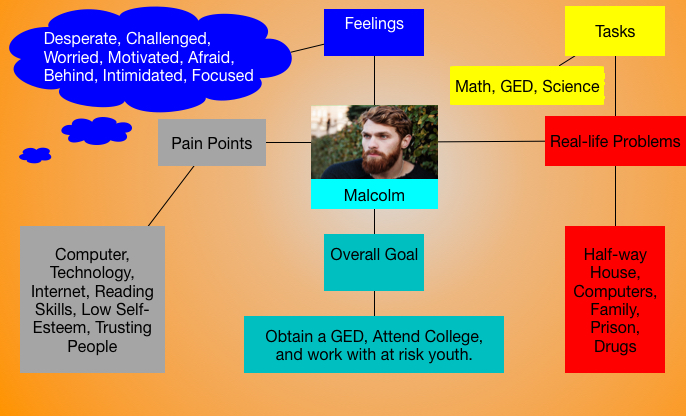(Kouprie & Visser, 2009)
Currently, I am volunteering for Designers for Learning providing instructional design for adult basic education (ABE) centers. I.D.’s progress through a course named instructional evaluation that guides you through the I.D. process of analyzing, evaluating, and redesigning ABE materials. I completed the first module today; which, acts as a SME of sorts providing an intensive overview of the ABE landscape.
During this phase of the I.D. process the focus was not only on understanding the ABE programs and their history, but the types of students in the programs. A reflection activity had the I.D.s develop an empathy mind map, which represented an ABE student persona that resonated with them. I picked Malcolm a student who’s mother passed away when he was young, farther went to prison shortly after, was abused in foster care, became a drug dealer and user, went to prison, and upon release continued to do drugs and steal until admitting himself to a half-way house for help. Now he is off drugs, and working to obtain his general education diploma (GED) in order to go to college and eventually become a counselor for at risk youth. There were vast amounts of information on Malcolm that I am not going to bore you with; though I will provide part of my process for this module below.
I.D.’s were asked to follow the process here:
Discover: Raise your curiosity. Enter the world of these people. Explore and discover the people, their situation, and experiences.
Immerse: Wander around in their world. Expand your knowledge about the people. Give them names. It is okay to be surprised by various aspects that influence their experience and circumstances. What may be their hopes, fears, and dreams? Be open-minded. Don’t judge. Get interested in their point of reference.
Connect: Resonate with these learners as people. Call upon your own memories and experiences in order to reflect and be able to create an understanding. Make a connection on an emotional level with the people by recalling your own feelings and resonating with their experience.
Detach: Step back and make sense of their world. Reflect as an instructional designer designing with the learner’s perspective on new insights for ideas to help them. What may they want to accomplish? What learning activities and delivery methods can be used? How can you provide opportunities for your learner(s) to engage in learning experiences and activities that can prepare them for the high school equivalency exam?
This is an excerpt of my final analysis of Malcolm:
In high school he was an average student and enjoyed computer classes. He tested at a tenth grade reading level, and is behind in his math abilities. Science is another area he is struggling. He does not have a connection to the STEM classes in the GED program and is unsure of its relevance to his situation. Malcolm has trust issues with adults, and authority. He feels that catching up might not be possible and low self-esteem is further hindering his success. Malcolm’s Internet access and computer access is likely to be outdated and his knowledge of using technology is lacking. However, the public library would be a good place to utilize technology for practice that is needed in the 21st century school and workplace to excel. The STEM learning activities need to be designed in such away it provides Malcolm with an overview of its importance to ensure buy-in. His reading level will allow him to successfully navigate instruction on various topics, yet he needs practice to ensure he can comprehend the text well. Lessons should provide a taste of the college environment to prepare Malcolm for success in academia, but not so much it is over whelming. Deliberate lesson progression will build his self-esteem and allow for a steady influx of knowledge that is not overwhelming. Malcolm has the ability and opportunity to reach his goals as he displays intrinsic motivation; however, he needs to improve his self-worth to stay motivated. As instructional designers, we can achieve these outcomes by incorporating expectancy-value theory to show task value and attribution theory to improve self-esteem during the design process.
Overall, this process was well worth the time and effort and I can see the benefit of producing an empathy mind map when working in a verity of situations as an instructional designer. The students in ABE programs do not have access to the Internet or a quality computer in many cases. However, they all have access to a phone and I would suspect smart phones. Therefore, creating an app for a phone that produces interactive, content, and has xAPI benchmarks would be helpful to this population of learners.
Here is a look at my empathy mind map.

Until next time…
Reference
Kouprie, M., & Visser, F. S. (2009). A framework for empathy in design: stepping into and out of the user’s life. Journal Of Engineering Design, 20(5), 437-448. doi:10.1080/09544820902875033